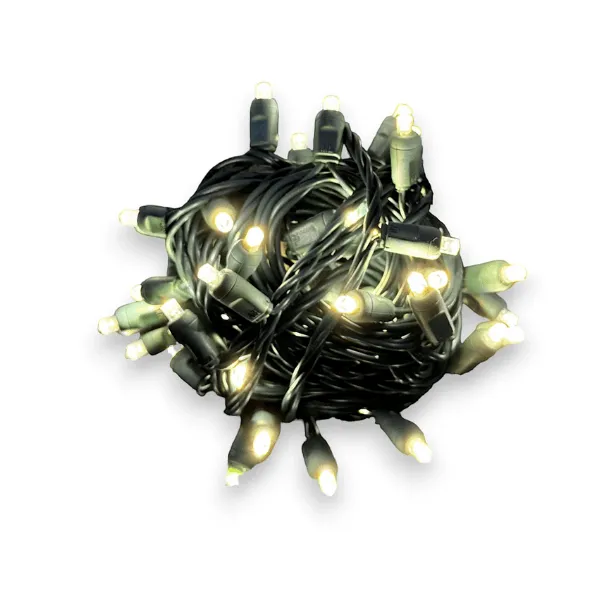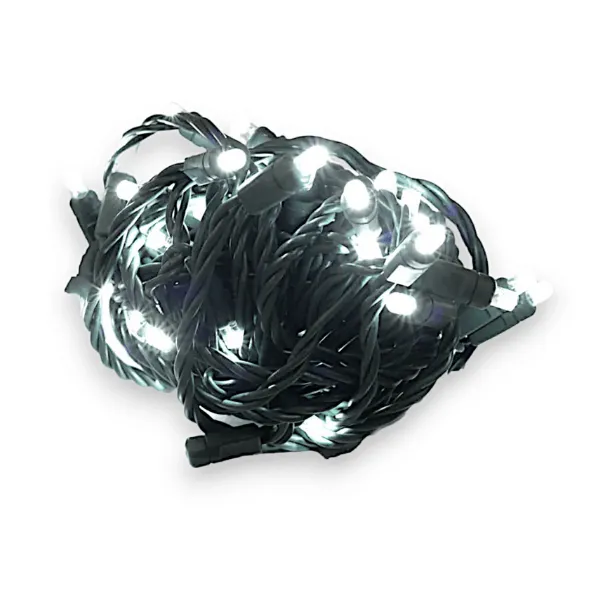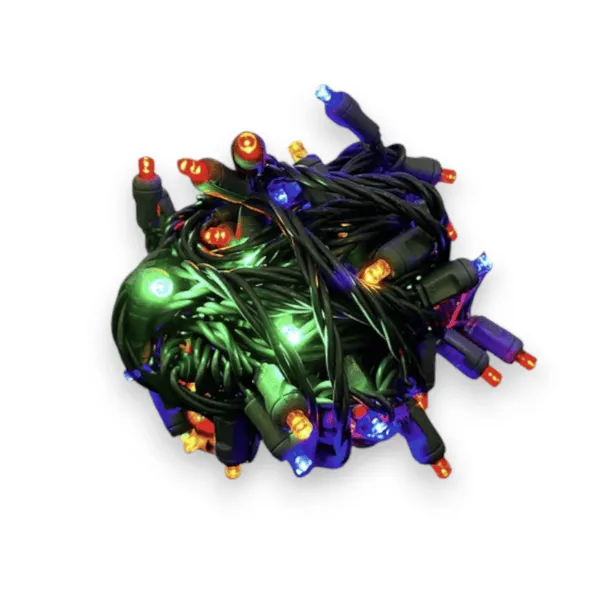Wholesale Pricing Presale Christmas Lights Minis
Pre-Season 50L 6" Spacing 5mm LED Mini Lights (Concave) 24/Case
AS LOW AS $6.95 Per STRAND!
Transform your holiday displays with the ultimate lighting solution: our 50 Count 5mm Wide LED Lights. Designed with professional installers and large-scale projects in mind, these lights offer unmatched performance and reliability. Whether you're wrapping trees, accentuating architectural features, or illuminating expansive commercial spaces, these lights deliver vibrant, uniform brilliance with every string. Built to last, energy-efficient, and easy to set up, they are the go-to choice for anyone looking to create stunning, worry-free displays this season. From their patented one-piece construction to their pre-balled convenience, these LED mini lights are engineered to save you time, money, and effort while dazzling your clients and guests.
Key Features:
50 Count 5mm Wide LED Lights: Each string features 50 high-quality LED bulbs spaced 6 inches apart on a 25-foot green wire. These lights are ideal for wrapping trees, bushes, and architectural features, providing a uniform and vibrant display that enhances any project.
High Connectivity for Large Installations: Connect up to 45 strings safely, allowing you to tackle large-scale installations with ease. This makes them perfect for professional installers managing multiple projects or expansive commercial properties.
Long-Lasting Performance: With a lifespan of up to 50,000 hours, these LED lights are built to withstand the rigors of professional use, ensuring they remain bright and reliable throughout the holiday season and beyond.
Patented One-Piece Construction: The innovative design prevents moisture-related corrosion, offering longer-lasting performance in all weather conditions. This durability is essential for outdoor installations where reliability is a must.
Energy Efficiency for Cost Savings: These LED mini lights consume up to 90% less energy than traditional incandescent bulbs, allowing you to reduce operational costs while maintaining a stunning display. This efficiency is especially important for large installations where energy consumption can quickly add up.
Virtually Unbreakable: The bulbs are engineered to be virtually unbreakable, with colors that won’t fade, chip, or crack. This durability means fewer replacements and more time to focus on new projects.
Pre-Balled for Efficient Setup: Time is money in professional installations, and these pre-balled lights ensure quick and easy setup, allowing you to complete projects faster and move on to the next job.
Meets UL 588 Safety Standards: Compliance with UL 588 safety standards ensures these lights are safe for both indoor and outdoor use, giving you peace of mind as you install them in various environments.
Illuminate your holiday displays with 50-count 5mm wide Minleon LED lights, spaced 6 inches apart on a durable 25-foot green wire. Designed for professional-grade performance, these lights allow you to safely connect up to 45 strings, making them perfect for large-scale installations. With a lifespan of up to 50,000 hours and energy-efficient LEDs that use 90% less energy than traditional bulbs, these lights offer long-lasting brilliance while saving on costs. Virtually unbreakable and pre-balled for hassle-free setup, they meet all UL safety standards and perfectly match the color temperature of Minleon C7 and C9 bulbs for a seamless, polished display.
Key Features:
50-count 5mm wide Minleon LED lights, spaced 6″ apart on green wire, with a total length of 25ft.
Safely connect up to 45 strings, making large displays easy to create.
Lifespan up to 50,000 hours, ensuring your lights last season after season.
Energy-efficient LEDs, using up to 90% less energy than traditional lights.
Virtually unbreakable bulbs that won’t fade, chip, or crack over time.
Pre-balled for easy Installation, so you can set up quickly and hassle-free.
Meets all UL safety standards, ensuring your display is safe and reliable.
All White temperature match to the C7&C9 Minleon Bulbs
Pre-Season 70L 4" Spacing Concave LED Mini Lights - 24/Case
As Low as $7.92 per Strand
Create dazzling, high-impact displays with 70 Count 5mm Wide LED Lights. Featuring 70 LED bulbs spaced just 4 inches apart on a 23.5-foot green wire, these lights deliver a denser, brighter, and more vibrant illumination that grabs attention. Safely connect up to 45 strings for expansive installations, while their energy-efficient design reduces power usage by up to 90%. Built for durability, these lights feature patented one-piece construction to prevent moisture-related issues and virtually unbreakable bulbs that maintain their vivid color. With a lifespan of up to 50,000 hours, pre-balled convenience for quick setup, and compliance with UL 588 safety standards, these lights are the ultimate choice for reliable, professional-grade installations indoors or outdoors.
Key Features:
70 Count 5mm Wide LED Lights: With 70 LED bulbs spaced 4 inches apart on a 23.5-foot green wire, these lights offer a more concentrated and impactful look compared to 50L sets. The smaller spacing results in a denser display of lights, drawing more attention with brighter, more intense illumination.
High Connectivity: Safely connect up to 45 strings, making these lights ideal for extensive installations that require consistent, reliable lighting across large areas.
Long Lifespan: Enjoy up to 50,000 hours of bright, consistent light. These bulbs are built to last, reducing the need for frequent replacements and maintenance.
Patented One-Piece Construction: This design eliminates the risk of moisture-related corrosion, ensuring longer-lasting lights even in challenging outdoor environments.
Energy Efficient: LED technology allows these lights to use up to 90% less energy than traditional incandescent bulbs, lowering energy costs and enabling longer runs without overloading circuits.
Virtually Unbreakable Bulbs: The durable construction of these bulbs ensures they are virtually unbreakable, with colors that won’t fade, chip, or crack, keeping your displays vibrant year after year.
Pre-Balled for Quick Setup: These lights come pre-balled, making installation quick and easy, allowing you to complete projects faster and with less effort.
Meets UL 588 Safety Standards: These lights are certified for both indoor and outdoor use, meeting all safety standards and providing peace of mind during installation.
Pre-Season Minleon 70L Mini Lights - 24/Case
AS LOW AS $9.37 Per STRAND!
Light up your displays with 70-count Minleon LED lights, spaced 4 inches apart on a durable green wire for a concentrated, eye-catching look. These energy-efficient LEDs use 90% less power than traditional lights and have a remarkable lifespan of up to 50,000 hours, ensuring they shine season after season. Safely connect up to 45 strings for effortless large-scale installations, while virtually unbreakable bulbs maintain their vibrant colors without fading, chipping, or cracking. Pre-balled for quick and easy setup, these lights meet all UL safety standards, making them a reliable, hassle-free choice for indoor and outdoor use.
Key Features:
These bulbs are made of durable, multi-faceted plastic so they won't fade, chip, or break like incandescent bulbs
Reduce your power consumption by more than 90% compared with conventional incandescent bulbs)
0.58W and 0.66W actual power consumption, but use 2W for installation calculation purposes
Fits into any standard C7 socket; E12 base
Frequently Asked Questions
Can I use these lights outdoors?
Yes, these lights are built for both indoor and outdoor use. They meet UL 588 safety standards, ensuring they are safe and reliable in all environments.
What is the lifespan of the Minleon LED mini lights?
The Minleon LED mini lights have an impressive lifespan of up to 50,000 hours, ensuring they remain bright and reliable for multiple holiday seasons.
How many strings of lights can I safely connect together?
You can safely connect up to 45 strings of Minleon LED mini lights, making them perfect for large-scale installations or extensive holiday displays.
Are these lights energy-efficient?
Absolutely! The LED technology in these lights uses up to 90% less energy than traditional incandescent bulbs, helping you save on energy costs while still delivering a brilliant display.
What makes these lights more durable than others?
The Minleon LED mini lights are designed with virtually unbreakable bulbs that are resistant to fading, chipping, or cracking, and they feature a patented one-piece construction that prevents moisture-related corrosion for longer-lasting performance.
How easy is it to install these lights?
These lights come pre-balled, making the setup process quick and hassle-free, so you can complete your installations faster and move on to the next job with ease.
What is the difference between concave vs convex
Concave Christmas lights feature a flat or slightly rounded top with a wider, bowl-shaped base. This design distributes light evenly in all directions, creating a bright, uniform glow visible from any angle. Professionals often choose concave lights for projects like wrapping trees because the even light distribution creates a sparkling effect as you move around the tree, adding depth and vibrancy to the display. In contrast, convex Christmas lights have a rounded or dome-shaped bulb that focuses light outward in a more directional manner. This creates a brighter, more concentrated point of light, making them ideal for installations requiring precise lighting placement, such as highlighting architectural features. Both designs offer unique benefits depending on the desired effect and application.
Discover Expert Tips on Our Blog

Christmas Light Business: It's GO TIME (Stop Waiting, Start Winning)
The season has officially begun. Across the country, Christmas lights installers are closing jobs, completing installations, and generating significant revenue. Some are doing $10,000-$20,000 per day, while first-year installers are landing their initial contracts and experiencing the thrill of building a real business. The difference between those who succeed and those who stay stuck comes down to one critical factor: taking action versus waiting for perfect conditions.
Winners vs. Waiters: Which One Are You?
There are fundamentally two types of people in the Christmas lights business right now: winners and waiters. Understanding which category you fall into determines whether you'll build a thriving six-figure business or remain stuck making excuses.
The Waiter Mindset
Waiters use specific language patterns that reveal their thinking:
"I'm not ready yet"
"I hope things work out"
"Someday I'll start"
"I'm waiting for my logo to be perfect"
"I need everything in place first"
These phrases are excuses disguised as planning. Waiters believe they need perfect conditions before launching. They obsess over logos, website details, and equipment specifications while potential customers hire competitors who took action weeks ago.
Consider the cost of waiting. Every day spent perfecting minor details represents lost revenue. Those customers calling competitors today could have been your customers if you'd launched earlier with "good enough" systems rather than waiting for perfection.
The Winner Mindset
Winners operate differently. They:
Put out yard signs even if the design isn't perfect
Close jobs before they've personally installed a single light
Take messy action and learn from failures
Start before they feel ready
Focus on revenue-generating activities over administrative perfection
Winners understand that you can make things prettier later. You can refine systems, improve marketing materials, and upgrade equipment—but only if you're generating revenue. Perfection is the enemy of progress, and progress is what pays the bills.
Google's automated ranking systems are designed to present helpful, reliable information that's primarily created to benefit people, not to gain search engine rankings. Similarly, your business should focus on serving customers rather than achieving operational perfection that customers never see.
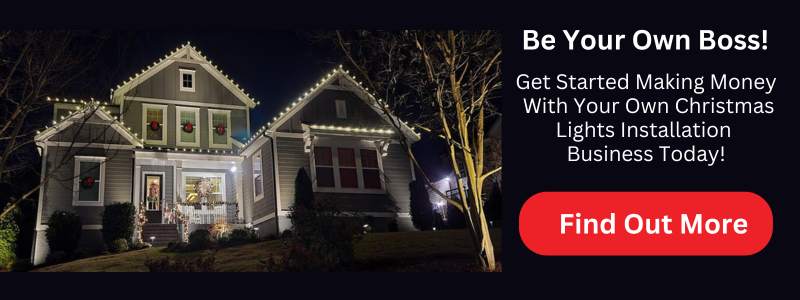
The Power of Networking in an AI-Driven World
As artificial intelligence becomes more sophisticated, one competitive advantage remains irreplaceable: genuine human relationships. The book "Never Eat Alone" provides a masterclass in networking that becomes increasingly valuable as AI commoditizes technical skills.
Why Networking Matters More Than Ever
With AI, anyone can create professional websites, generate marketing copy, and even produce convincing videos. Technical barriers that once protected established businesses are disappearing. In this environment, relationships become your most defensible competitive advantage.
Successful installers generate $150,000-$200,000 annually from commercial work—almost entirely through networking. These contracts don't come from yard signs or Facebook ads. They result from relationships built over months or years, where decision-makers trust you personally and recommend your services to colleagues.
One installer generated $1.8 million in pressure washing revenue last year, much of it originating from LinkedIn connections that evolved into networking relationships. Initial online contact led to coffee meetings, referrals to friends, and eventually major contracts that would never have come through traditional advertising.
Building a Network That Generates Revenue
Effective networking isn't about collecting business cards at Chamber of Commerce meetings. It's about genuine relationship building where you add value first. Consider these approaches:
LinkedIn for Commercial Opportunities: Many installers overlook LinkedIn, treating it as a resume platform rather than a business development tool. Posting relevant content about holiday lighting, engaging with local business posts, and reaching out to facility managers and property owners can generate $15,000-$20,000 single contracts.
Local Business Relationships: The landscaper with 28 crew members needs someone to handle holiday lighting for his clients. The property management company managing 50 HOAs needs a reliable installer. The event planner coordinating corporate functions needs lighting expertise. These relationships don't form through advertising—they develop through intentional networking.
Referral Partnerships: An irrigation repair business that slows during holidays can send leads your way. In exchange, you refer landscape lighting customers to them during peak season. These mutually beneficial arrangements multiply lead generation without additional marketing costs.
Pricing Confidence: Charging What You're Worth
The single biggest factor limiting installer income is pricing confidence. Many charge $3.50-$6.00 per foot when they could command $8.00-$14.00 or even $20.00 per foot. The barrier isn't market conditions—it's self-belief.
The $6 vs. $8 Per Foot Reality
Here's a truth that challenges conventional wisdom: if you can't sell jobs at $6 per foot, you probably won't sell them at $8 per foot either. Conversely, if customers will pay $6 per foot, they'll often pay $8 per foot when value is properly presented.
The difference isn't price—it's confidence and presentation. When you speak hesitantly, use filler words ("um," "uh," "like"), and focus on bulbs rather than benefits, customers sense uncertainty. They question whether you're truly professional and capable.
One installer raised prices from $3.50 to $7.00 per foot, fearing massive customer loss. Instead, closing rates remained steady. Customers willing to pay $3.50 were equally willing to pay $7.00 when the service was positioned as professional, hassle-free, and creating magical family memories.
Breaking Through the $6 Per Foot Myth
When installers insist "nobody in my area will pay more than $6 per foot," they're revealing limiting beliefs rather than market realities. Consider these questions:
How many Starbucks are in your area? Count cars going through the drive-through daily. Multiply by $10 per person, then by 30 days. That's over a million dollars monthly flowing through one coffee shop in your "poor" area.
How many Mercedes, BMWs, or $50,000+ vehicles do you see daily? People making $800 monthly car payments exist in your market.
How many people carry $300, $3,000, or even $30,000 handbags versus $3 Walmart bags? They all serve the same function, yet some pay 10,000 times more for essentially the same product.
How much do Rolex watches, regular manicures, and designer clothes cost in your area? If people spend thousands on these discretionary items, they'll invest in creating magical holiday memories for their families.
The money exists in every market. The question is whether you believe your service is worth premium pricing.
The Real Cost of Underpricing
Charging $6 per foot when you should charge $10 per foot isn't just leaving money on the table—it's making the business unsustainable. Consider the math:
To generate $100,000 revenue at $6/foot requires 16,667 feet of installation
The same $100,000 at $10/foot requires only 10,000 feet of installation
That 6,667-foot difference represents weeks of labor, substantial material costs, and significant safety risk exposure. Underpricing doesn't make you competitive—it makes you exhausted and unprofitable.
Furthermore, low-price customers tend to be more demanding, less loyal, and more likely to complain. Premium-priced customers value quality, professionalism, and convenience, making them ideal long-term relationships.
Taking Messy Action: The Path to Success
The most successful installers share one trait: they take imperfect action rather than waiting for ideal conditions. This bias toward execution compounds over time, creating momentum that analysis paralysis never generates.
Starting Without Perfect Conditions
One installer came to training five years ago in a cramped, wet garage with minimal equipment. He left being told he could realistically make $30,000-$50,000 his first year. He thought that prediction was crazy. He made $32,000 that first partial season. Last year, he did $500,000. This year, he's already closed $300,000 by early October.
The vast majority of sites listed in our results are found and added automatically as we crawl the web. Similarly, most business success comes from consistent execution of fundamentals rather than sophisticated strategies. That installer didn't have perfect systems, premium equipment, or years of experience—he had commitment to taking action despite uncertainty.
What Messy Action Looks Like
Yard Signs That Aren't Perfect: One installer put out 750 yard signs with only his website—no phone number. He made just $35,000 from that massive effort. After learning the lesson, he redesigned signs with large phone numbers. Keep it simple: big text showing what you do, prominent phone number, nothing else.
Closing Jobs Before Installing Your First Light: Many successful installers closed $10,000-$20,000 in contracts before personally installing a single bulb. They learned techniques through training, sold confidently based on that knowledge, then executed installations or hired help.
Starting in Late October: It's absolutely not too late to start a Christmas lights business in late October. Installers who attend training the last weekend of October and execute recommended strategies can realistically generate $30,000-$100,000 in their first partial season.
Learning From Failure
Messy action produces failures, and failures generate learning. That's how growth happens. When you discover that yard signs with only websites don't work, you've learned a valuable lesson. When you realize that talking about LED specifications bores customers, you adjust to selling emotions and benefits.
Winners fail frequently but learn quickly. Waiters avoid failure by avoiding action, ensuring they never learn the lessons that drive success.
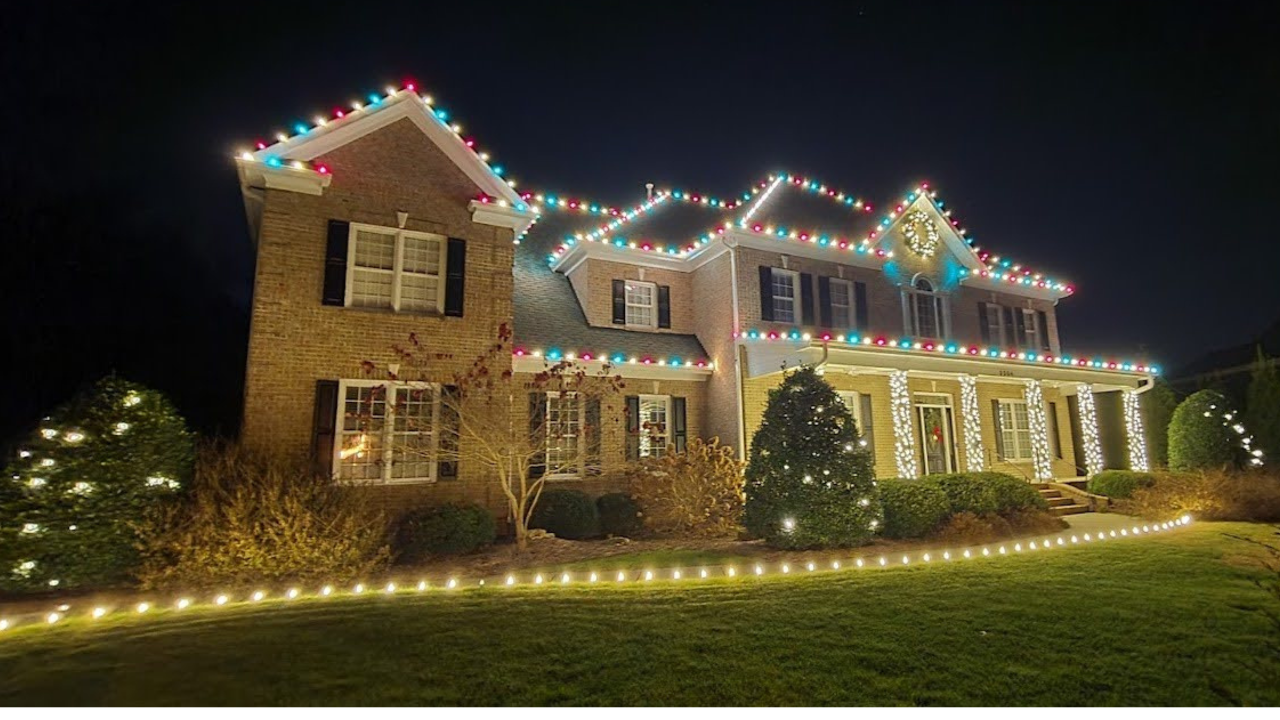
Your Go Time Action Plan
If you're ready to be a winner rather than a waiter, here's your immediate action plan:
This Week's Marketing Priorities
Order 500-1,000 yard signs from moneybushes.com. These are "money bushes"—plant them and revenue grows. Get them ordered immediately, as production and delivery take 1-2 weeks.
Post in 5 local Facebook groups about your services. Include groups like community pages, HOA groups, and local business networks.
Post on LinkedIn positioning yourself as the local holiday lighting expert. Share educational content about safety, convenience, and professional installation benefits.
Join and post in local mom groups. Mothers are typically primary decision-makers for holiday decorating and actively seek recommendations in these communities.
Update your Google Business Profile daily with photos, posts, and updates. Search engines analyze content to assess whether it contains information relevant to what you are looking for, and systems look for quantifiable signals to assess relevance. Consistent posting signals active business and improves local search visibility.
Making Every Hour Count
If you're not busy with installations yet, you should spend 4-8 hours daily on marketing activities:
Making outbound calls to potential commercial clients
Door knocking in target neighborhoods
Posting on social media platforms
Following up with leads who haven't yet converted
Networking at local business events
This relentless focus on lead generation continues until you're so busy with work that marketing time naturally decreases. But in these early weeks, generating leads is your full-time job.
Equipment and Materials: Start Simple
Don't overcomplicate initial equipment purchases. You need:
Quality bulbs with warranties: Elite-grade LED bulbs with 5-year warranties prevent callbacks and protect reputation. Cheap bulbs fail frequently, creating expensive service calls and damaged customer relationships.
Premium socket wire: Admiral brand or similar quality wire withstands weather and prevents socket disconnections. Cheap wire allows sockets to pull off, causing shorts and safety hazards.
Clips and connectors: Stock various clip types (tough clips, flex clips) and maintain a 3:1 ratio of female to male connectors. Each string needs one male plug but multiple female connectors for extensions.
28-foot extension ladder: Aluminum for light weight. A 28-foot ladder handles 95% of residential installations in most markets. While 32-foot provides extra reach, the additional weight makes daily use exhausting.
Ladder stabilizer: Prevents gutter crushing, improves safety, and protects paint from scratches as you move the ladder.
Focus initial spending on marketing (yard signs) rather than excessive equipment inventory. It's better to have jobs you need to buy equipment for than equipment sitting unused because you don't have customers.
The 50% Deposit Strategy
Many new installers wonder how to fund materials when starting with limited capital. The solution is simple: collect 50% deposits when booking jobs.
When customers commit to installation, request 50% down to secure their spot on the schedule. This isn't about explaining you need money for materials—it's positioning the deposit as what's required to be scheduled. That deposit funds material purchases for their job and subsequent installations.
This approach allows you to scale without significant upfront capital. Sell $20,000 in jobs, collect $10,000 in deposits, buy materials and equipment, complete installations, collect final payments, and repeat. Each cycle builds working capital for larger growth.

Dealing With Yard Sign Removal
One common concern: what do you do when competitors or "sign Karens" remove your yard signs?
Put out more signs. Give them more work to do. The goal isn't preventing removal—it's maintaining high visibility despite removal. Deploy hundreds of signs, expect some percentage to disappear, and continuously replenish.
Strategic placement: Put signs out Friday evenings so they have maximum weekend visibility before potential Monday removal. Place some in difficult-to-access locations where removal requires effort most people won't invest.
Nighttime deployment: Placing signs late evening or early morning when fewer people are around reduces immediate removal. Don't get hit by cars—safety matters more than any marketing campaign.
The return on yard sign investment far exceeds the frustration of occasional removal. One installer put out signs, turned around, and saw someone collecting them into her Subaru to "clean up the streets." His response? Put out more signs.
Overcoming the "My Area Is Different" Excuse
Every market has installers insisting their area won't support premium pricing. Meanwhile, other installers in the same market charge $10-$14 per foot successfully. The difference isn't the market—it's the mindset.
One installer in a supposedly "cheap" market with major $6/foot competition now charges $10-$14 per foot successfully. Some of his jobs reach $20 per foot. He's not serving a different market—he's presenting value differently and attracting quality-focused customers rather than price shoppers.
Content should clearly demonstrate first-hand expertise and a depth of knowledge, and after reading your content, will someone leave feeling they've learned enough about a topic to help achieve their goal? Similarly, when you demonstrate expertise, professionalism, and the transformative experience you provide, customers focus on value rather than price.
If you genuinely live in a rural area where premium pricing is impossible, consider driving to wealthier nearby markets. One successful installer drove an hour each way to the northeast side of Cincinnati because that's where his target customers lived. The additional drive time was worth accessing customers who valued quality service.
The Weekend That Changes Everything
For those serious about building a thriving Christmas lights business, in-person training provides immersive learning impossible to replicate through videos or books. Upcoming weekend training sessions offer:
Friday: Technical Installation Training
Hands-on practice with professional equipment (Pitch Hopper, Goat Steep Assist)
Installation on actual roofs, poles, and trees
Troubleshooting common issues
Safety protocols and best practices
Systems for efficient installation
Saturday: Business Growth and Sales
Marketing strategies that generate consistent leads
Sales processes that close premium-priced contracts
Leadership development for managing crews
Hiring strategies from experts who've built multiple crews
Networking with successful installers doing six and seven figures
The Saturday business training often provides more value than Friday's technical instruction. Installation techniques can be learned through practice, but sales, marketing, and leadership skills require modeling from successful practitioners.
Classes typically run 10-15 attendees, providing intimate environments for questions, networking, and relationship building. Several current seven-figure installers attend these trainings repeatedly because the networking and idea exchange with other successful operators generates ideas worth tens of thousands in additional revenue.

What if I don't have money for equipment and materials?
Start by selling jobs and collecting 50% deposits. Use those deposits to purchase materials for each job. Begin with one or two installations to generate cash flow, then scale from there. Don't buy significant inventory before having confirmed customers. It's better to sell jobs you need to buy materials for than own materials you can't sell.
How many yard signs should I deploy?
Start with 500-1,000 signs minimum. Plan to deploy 100-200 per week throughout November. It takes 6-8 hours to place 100 signs, so budget time accordingly. Signs are "money bushes"—plant them and revenue grows. This remains one of the highest-ROI marketing investments available.
Is it really not too late to start in late October?
Absolutely not too late. Installers who attend training the last weekend of October and execute recommended strategies consistently generate $30,000-$100,000 in their first partial season. The key is immediate action on marketing and confident premium pricing. Most sales momentum comes in November anyway, so late October launches work well.
Should I practice on friends' houses before selling real jobs?
Only if you have excess cash for materials. Otherwise, invest that money in 500 additional yard signs instead. You'll learn more from live customer installations than practice houses, and you'll be paid to learn. If you want hands-on practice first, attend in-person training where you can practice on real roofs with professional equipment and immediate feedback.
What do I do when competitors charge much less than my premium pricing?
Recognize that you're serving different market segments. Low-price competitors attract price-sensitive customers who compare primarily on cost. Your premium pricing attracts quality-focused customers who value professionalism, convenience, and results. These are different buyer profiles. Marketing and sales process should filter for your ideal customers rather than competing for everyone.
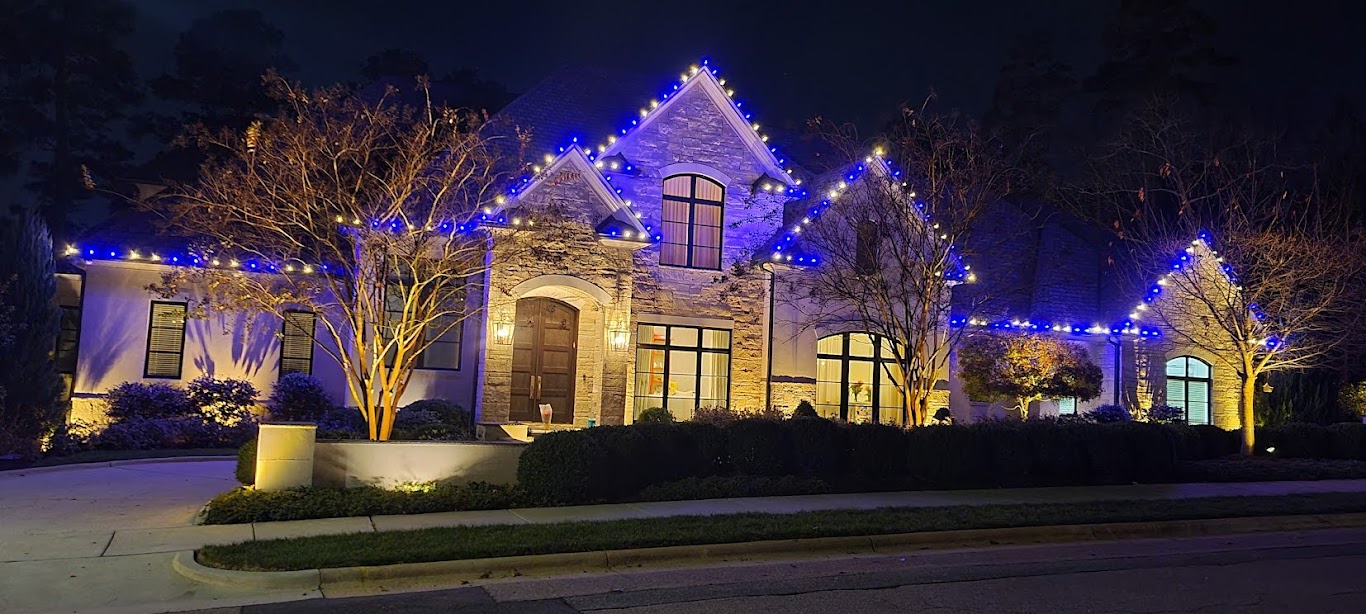
How do I handle people who say nobody in their area will pay premium prices?
Count Starbucks customers in your area for one day. Calculate daily revenue ($10 average × customer count × 30 days). Observe how many luxury cars, designer accessories, and discretionary purchases happen in your "cheap" market. The money exists—the question is whether you believe your service merits premium pricing. If you don't believe it, customers won't either.
What's the most important factor for first-year success?
Taking messy action despite imperfect conditions. Winners start before they're ready, learn from failures, and adjust quickly. Waiters seek perfect conditions that never arrive. Your first installation won't be perfect, your first sales call will be awkward, and your first marketing attempts will produce mixed results. That's exactly how growth happens—through doing, failing, learning, and improving.
How do I overcome self-doubt and pricing confidence issues?
Surround yourself with successful people who reinforce abundance thinking and premium pricing. Join communities, attend trainings, and build relationships with installers doing six and seven figures. Their confidence and success stories normalize what seems impossible from your current perspective. Additionally, focus on selling benefits (family memories, safety, convenience) rather than features (bulb specifications, wire gauge) to shift conversations from price to value.
What should I prioritize: technical installation skills or sales and marketing?
Sales and marketing generate revenue; installation skills fulfill contracts. Both matter, but sales and marketing determine whether you have a business. You can hire installers or learn installation through practice, but if phones don't ring, technical skills are worthless. Prioritize lead generation and sales initially, then develop installation capabilities to fulfill the work you've sold.
How much can I realistically make in my first year?
First-year installers executing recommended strategies typically generate $30,000-$100,000 in partial seasons starting late October. Those beginning earlier can reach $50,000-$150,000. Year two often sees 2-5x growth as reputation, reviews, and refined systems compound. By year three, $250,000-$500,000 becomes achievable for committed operators. These aren't guarantees—they're realistic outcomes for those who take consistent action, price confidently, and focus relentlessly on marketing and sales.
Copyright ©2025 All Right Reserved website designed by christmaslights.io
Terms of Service / Privacy Policy
Have questions or need assistance?
Contact us at (855)619-LITE



